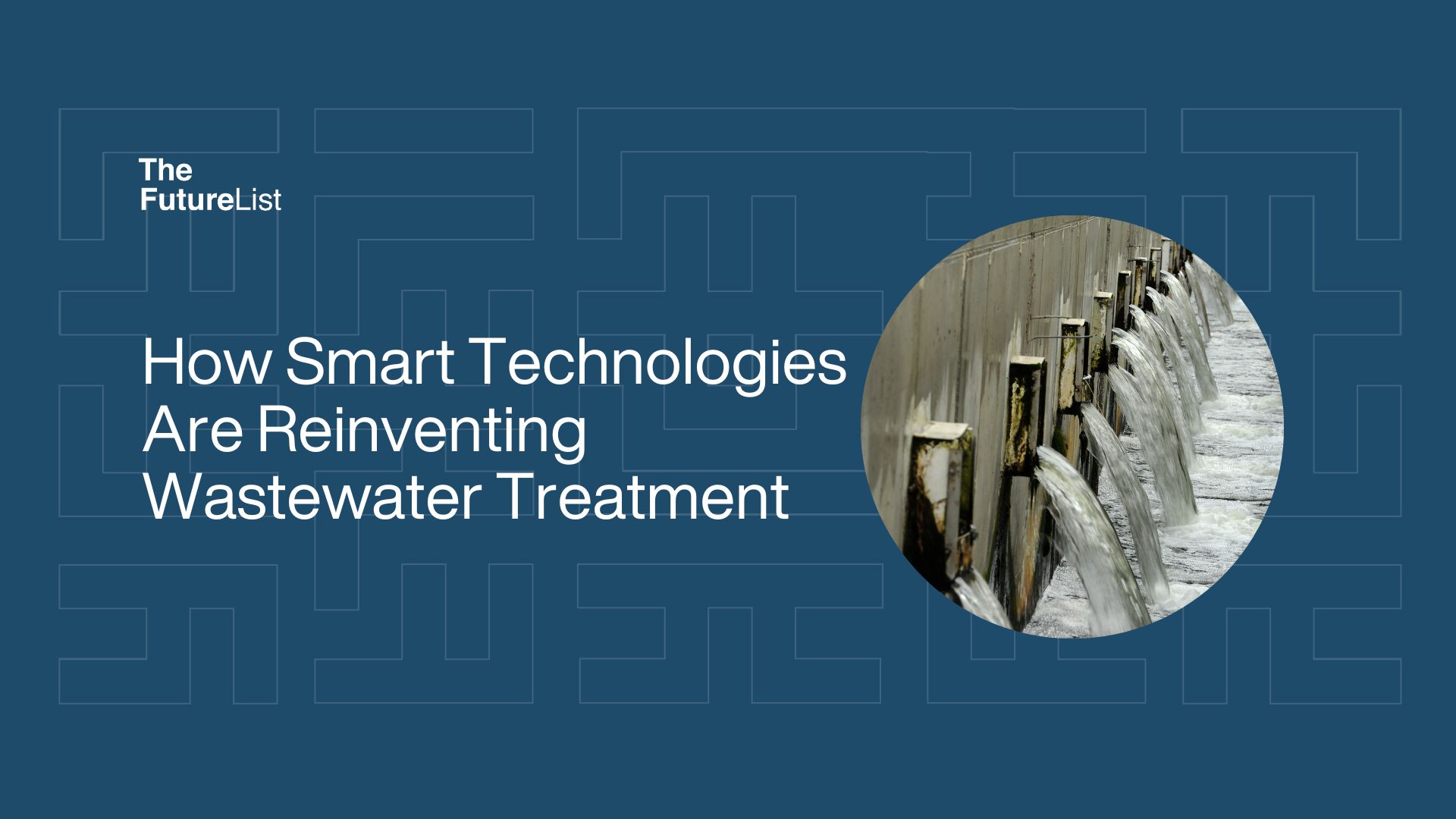
How Smart Technologies Are Reinventing Wastewater Treatment
By Henry Duah
As global demand for clean water intensifies and water stress becomes a defining challenge of our time, traditional views of wastewater are undergoing rapid evolution. No longer seen merely as waste, wastewater is now recognised as a valuable resource: one that can be reclaimed to yield clean water and even generate energy. This shift is being driven by a wave of technological innovations that are transforming how we treat and reuse wastewater.
Conventional systems, often energy- and land-intensive, are proving insufficient in the face of rapid urbanisation, industrial expansion, and climate change. In their place, a new generation of innovative, efficient, and sustainable solutions is emerging. These latest innovations are designed to improve treatment outcomes and to optimise the entire lifecycle of wastewater. From AI-powered optimisation to advanced membranes and nanomaterials, these integrated innovations are reshaping wastewater treatment by prioritising efficiency, resilience, and environmental sustainability.
In this innovation snapshot, we examine some innovative approaches to treating wastewater effectively and efficiently (Shamshad & Rehman, 2025).
Innovative and Smart Approaches to Wastewater Treatment
Membrane Technologies
Membrane-based filtration systems have revolutionised wastewater treatment by offering precision and efficiency. These systems use semi-permeable membranes to separate contaminants from water at a molecular level. These membrane technologies include:
- Microfiltration (MF) removes large particles, such as suspended solids and bacteria.
- Ultrafiltration (UF) targets viruses, proteins, and colloidal matter.
- Nanofiltration (NF) filters out divalent ions, pesticides, and organic molecules.
- Reverse Osmosis (RO) offers the most advanced level of filtration, removing even monovalent salts and pharmaceuticals.
Modern membranes are increasingly made from advanced materials, providing improved resistance to fouling and higher water flux. These are especially effective in industrial wastewater treatment, where contaminants are complex and varied. Membranes can also be combined with other systems (e.g., biological reactors) to create membrane bioreactors (MBRs), which deliver high-quality effluent suitable for reuse in agriculture, industry, or urban applications.
Advanced Oxidation Processes (AOPs)
AOPs are cutting-edge chemical treatment techniques that utilise highly reactive oxidising agents to break down pollutants that are difficult to remove. Common AOP techniques include:
- UV/H₂O₂ (ultraviolet light with hydrogen peroxide)
- UV/Chlorine
- Ozonation
- Fenton and photo-Fenton reactions
These processes are particularly effective against pharmaceutical residues, synthetic dyes, endocrine-disrupting compounds, and emerging contaminants that pass through conventional systems. AOPs can mineralise these pollutants into non-toxic end products, such as water and carbon dioxide.
Biological and Hybrid Treatment Systems
Biological treatment remains central to wastewater management, but new hybrid systems are enhancing its capabilities.
- Anaerobic treatment utilises microorganisms in oxygen-free environments to break down organic matter, producing biogas (primarily methane) as a byproduct, which can serve as an energy source.
- Aerobic treatment, more commonly used in urban settings, utilises oxygen-dependent bacteria to break down pollutants.
Innovative combinations, such as biological treatment followed by ozone sterilisation or MBRs (membrane bioreactors), offer improved removal rates, reduced sludge, and smaller land footprints.These systems are also effective in decentralised settings (e.g., small communities or industrial sites) where traditional infrastructure is lacking.
Artificial Intelligence and Real-Time Monitoring
AI and smart sensors are bringing intelligence into wastewater systems.
- Machine learning algorithms are used to predict influent characteristics, optimise chemical dosing, and detect anomalies before they become failures.
- Real-time monitoring systems measure parameters such as biological oxygen demand (BOD), chemical oxygen demand (COD), pH, and turbidity, providing operators with actionable insights in real-time.
These technologies enhance operational efficiency and minimise treatment errors. Smart water grids and AI-integrated platforms enable the dynamic control of treatment plants, which is especially useful in managing peak loads or unexpected inflows during floods or industrial discharges.
Nanotechnology and Electrochemical Treatment
Nanotech brings precision to pollution control. Carbon nanotubes and metal-oxide nanoparticles, such as titanium dioxide (TiO₂), offer high adsorption capacity and catalytic activity. Nanofilters can selectively remove molecules at a sub-nanometer scale. Additionally, electrochemical methods, such as electrocoagulation and electrooxidation, aid in degrading contaminants like cyanide, oils, and dyes by utilising controlled electric currents.
Renewable Energy Integration
Wastewater treatment has historically been energy-intensive, but modern treatments are embracing renewable energy to minimise environmental impact and operational costs. Solar panels can power UV disinfection or AOP systems. Integrating renewable energy transforms treatment plants into energy-neutral or even energy-positive facilities, contributing to broader sustainability goals and climate targets.
In conclusion, Innovation is unlocking the full potential of wastewater, transforming what was once seen as waste into a valuable resource that supports numerous industries. The integration of innovative materials, biological systems, AI, and clean energy is ushering in a new era of sustainable wastewater management. While challenges such as cost, scalability, and technical complexity remain, the continued convergence of disciplines from environmental engineering to nanoscience and AI promises a resilient future where wastewater plays a central role in solving the global water crisis.
References
Shamshad, J., & Rehman, R. U. (2025). Innovative approaches to sustainable wastewater treatment: a comprehensive exploration of conventional and emerging technologies. Environmental Science: Advances.
Get innovation insights from The FutureList weekly. Subscribe to our newsletter here
Categories
- Agritech
- Artificial Intelligence
- Biotech
- Blockchain
- Climate Tech
- Data Infrastructure
- Edtech
- Events
- Fashion
- Fintech
- Healthtech
- Infrastructure
- Innovation Memos
- Innovation Scout Program
- Insight
- Insurtech
- Machine Learning
- Martech
- Mobility
- Music and Media
- Partner Offers
- Perks
- Procurement
- Proptech
- Retailtech
- Ridehailing
- Ridesharing
- Robotics
- Space Aviation
- Supply Chain
- Talent
- Telecoms
- Uncategorized
- Venture Capital
- Wastetech
- Women In Tech
Recent Posts
- The Rise of Physical AI: Intelligence Moving Into the Real World
- Shaping the Future of Medicine: How Tiny Devices Are Revolutionising Vital Body Functions
- The Rural Health Operating System: Reinventing Access to Care in Africa
- Intelligent Grid Monitoring: How IoT and AI Are Powering the Future of Energy
- Innovation Memo with STEMAIDE: Hands-on STEM Education for Young Africans